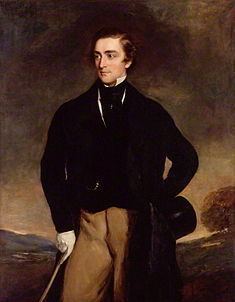Monarch Victoria Name Sidney 1st Role Statesman | Succeeded by Lord John Russell Parents Catherine Vorontsov Monarch Victoria | |
 | ||
Prime Minister The Viscount Palmerston Prime Minister The Viscount Palmerston Children Sidney Herbert, 14th Earl of Pembroke, George Herbert, 13th Earl of Pembroke Siblings Robert Herbert, 12th Earl of Pembroke, Catherine Murray, Countess of Dun Similar People Florence Nightingale, Sidney Herbert - 14th Earl, Elizabeth Herbert - Baroness, Baruch Spinoza, Jacques‑Benigne Bossuet | ||
Sidney Herbert, 1st Baron Herbert of Lea, PC (16 September 1810 – 2 August 1861) was an English statesman and a close ally and confidant of Florence Nightingale.
Contents
Early life
He was the younger son of George Herbert, 11th Earl of Pembroke; his mother being the Russian noblewoman Countess Catherine Woronzow (or Vorontsov), daughter of the Russian ambassador to St James's, Semyon Romanovich Vorontsov. The Woronzow Road in St John's Wood, London, is named after the family. Educated at Harrow and Oriel College, Oxford, he made a reputation at the Oxford Union as a speaker.
Career
Herbert entered the House of Commons as Conservative member of Parliament for a division of Wiltshire in 1832. Under Peel he held minor offices, and in 1845 was included in the cabinet as Secretary at War, and again held this office from 1852 to 1855, being responsible for the War Office during the Crimean War, and again in 1859.
Herbert was a member of the Canterbury Association from 20 March 1848.
Herbert ran the Pembroke family estates, centered at Wilton House, Wiltshire, for most of his adult life. His elder half-brother, Robert Herbert, 12th Earl of Pembroke (1791–1862), had chosen to live in exile in Paris after a disastrous marriage in 1814 (annulled 1818) to a Sicilian princess, Ottavia Spinelli (1779–1857), widow of Prince Ercole Branciforte di Butera, and daughter of the Duke of Laurino, and a subsequent liaison with Alexina Gallot, which resulted in four illegitimate children.
It was Sidney Herbert who sent Florence Nightingale out to Scutari, and with Nightingale led the movement for Army Health and War Office reform after the war. The hard work entailed caused a breakdown in his health, so that in July 1861, having been created a baron in the peerage of the United Kingdom, he had to resign office. He died from Bright's disease on 2 August 1861. His statue by Foley was placed in front of the War Office in Pall Mall, London, and after that building's demolition placed next to A.G. Walker's statue of Florence Nightingale in Waterloo Place, adjacent to the Crimean Monument.
Family
In the early 1840s, Herbert is thought to have had an affair with the noted society beauty and author Caroline Norton, who was unable to get a divorce from an abusive husband, so that the relationship ended in 1846.
In 1846 Sidney Herbert married Elizabeth (b. Richmond, 21 July 1822; d. Herbert House, London, 30 October 1911), only daughter of Lt.-Gen. Charles Ash à Court-Repington and niece of William à Court, 1st Baron Heytesbury. She was a philanthropist, author and translator, and a friend of Benjamin Disraeli, Cardinal Manning and Cardinal Vaughan. After her husband's death, Lady Herbert became an "ardent ultramontane" Roman Catholic, along with their eldest daughter, Mary.
Sidney and Elizabeth Herbert lived at 49 Belgrave Square, London, and had seven children:
- George Robert Charles Herbert (1850–1895), who succeeded in the title and later became the 13th Earl of Pembroke, and the barony is now merged in that earldom.
- Sidney Herbert (1853–1913), also a Member of Parliament, who succeeded his brother as the 14th Earl of Pembroke.
- William Reginald Herbert (1854–1870), lost at sea aboard HMS Captain, aged 16.
- Michael Henry Herbert (The Hon. Sir Michael Herbert, KCMG, CB, PC) (1857–1904), after whom the town of Herbert in Saskatchewan, Canada, is named, was a diplomat who ended his career as British Ambassador to the US in Washington DC in succession to Lord Pauncefote. He m. 1888 Lelia ('Belle'), daughter of Richard Thornton Wilson, Sr., a New York banker and cotton broker, and had (with one other son) Sir Sidney Herbert, 1st Baronet.
- Mary Catherine (1849–1935), who m. 1873 the great modernist theologian, Baron (Freiherr) Friedrich von Hügel.
- Elizabeth Maud (1851–1933), who m. 1872 the composer, Sir Charles Hubert Parry, 1st Baronet (son of Thomas Gambier Parry), of Highnam Court, near Gloucester.
- Constance Gwladys (1859–1917), who m. 1st 1878 St George Henry Lowther, 4th Earl of Lonsdale (issue, 1 daughter) and m. 2ndly 1885 Frederick Oliver Robinson, the Earl de Grey, later 2nd and last Marquess of Ripon (no issue).
Sidney Herbert is buried in the churchyard at Wilton, rebuilt by his father in neo-Romanesque style, with inside the church a marble monumental effigy of him beside Elizabeth, his wife (who, however, was buried at St Joseph's Missionary College, Mill Hill, where she was a notable patron).
Herbert Sound in the Antarctic and Pembroke, Ontario in Canada are named after Sidney Herbert. Mount Herbert, the highest peak on Banks Peninsula, was named by the chief surveyor of the Canterbury Association, Joseph Thomas, in 1849.
